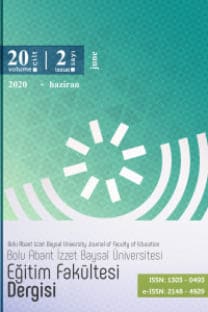SOMUT VE SANAL MANİPÜLATİF DESTEKLİ GEOMETRİ ÖĞRETİMİNİN 5. SINIF ÖĞRENCİLERİNİN GEOMETRİK YAPILARI İNŞA ETME VE ÇİZMEDEKİ BAŞARILARINA ETKİSİ
Somut manipülatifler, sanal manipülatifler, geometrik yapıları inşa etme, geometrik yapıları çizme
Concrete and Virtual Manipulative -Assisted Teaching of Geometry's Impact on the Success of Building and Drawing Geometric Structures of 5th Grade Students
Concrete manipulatives, virtual manipulatives, building geometric structures, drawing geometric structures,
___
- Assaf, S. A. (1986). The effects of using logo turtle graphics in teaching geometry on eight grade students’ level of thought, attitude toward geometry and knowledge of geometry.Dissertation Abstract Index, 46 (10), 2925A.
- Baki, A. (2006). Kuramdan Uygulamaya Matematik Eğitimi (3. Baskı). Derya Kitabevi, Trabzon.
- Baykul, Y. (1997). İlköğretimde Matematik Öğretimi. Ankara: Anı Yayıncılık.
- Bobango, J. C. (1988). Van Hiele levels of geometric thought and student achievement in standard content and proof writing: The effect of phase-based instruction. Dissertation Abstract Index, 48 (10) 2566A.
- Breen, J. J. (2000). Achievement of van Hiele level two in geometry thinking by eight grade students through the use of geometry computer-based guided instruction. Dissertation Abstract Index, 60 (07) 2415A.
- Carpenter, T. P., Levi, L., ve Farnsworth, V. (2000). Building a foundation for learning algebra in the elementary grades. Madison, WI: National Center for Improving Student Learning and Achievement in Mathematics Education.
- Clements, D. H. ve McMillen, S. (1996). Rethinking Concrete Manipulatives. Teaching Children Mathematics, 2 (5), 270-279.
- Clements, D. H. (1999). ‘Concrete’ Manipulatives, ‘Concrete’ Ideas, State Universty of New York, Buffalo, USA. Contemporary Issues in Early Childhood, l (1), 45-60.
- Clements, D. H., Battista, M. T. ve Sarama, J. (2002). Logo and geometry. Journal for Research in Mathematics Education. Monograph Number 10.
- Doruk, B. K., Kıymaz, Y. ve Horzum, T. (2012). İspat yapma ve ispatta somut modelden yararlanma üzerine sınıf öğretmeni adaylarının görüşleri. X. Ulusal Fen ve Matematik Eğitimi Kongresi, Niğde
- Durmuş, S. ve Karakırık, E. (2006). Virtual Manipulatives in Mathematics Education: A Theoretical Framework. TOJET, 5 (1).
- Gündüz, Ş., Emlek, B. ve Bozkurt, A. (2008). Computer Aided Teaching Trigonometry Using Dynamic Modelling In High School, 8th International Educational Technology Conference, 6-7-8-9 May 2008, Anadolu University, Eskişehir, 1039-1043
- Heddens, J. W. (1997). Improving Mathematics Teaching by Using Manipulatives. Kent State http://www.hkame.org.hk/html/modules/tinyd2/content/Edumath/v4/v4_47to 50 .pdf adresinden alınmıştır University.
- Karakırık, E. (2008). SAMAP: A Turkish Math Virtual Manipulatives Site. 15.08.2013 tarihinde alınmıştır. adresinden
- Karaman, T. (2000). The Relationship between gender, spatial visualization, spatial orientation , flexibility of closure abilities and the performances related to
- ISSN: 1303-0493
- Yayın Aralığı: Yılda 4 Sayı
- Başlangıç: 2000
- Yayıncı: Abant İzzet Baysal Üniversitesi Eğitim Fakültesi
Ayşe Nur KUTLUCA CANBULAT, Füsun YILDIZBAŞ
Yaratıcılığa teşvik edici öğretmen davranışları indeksi'nin (yödindeksi) türkçeye uyarlanması
YARATICILIĞA TEŞVİK EDİCİ ÖĞRETMEN DAVRANIŞLARI İNDEKSİ’NİN (YÖDİndeksi) TÜRKÇEYE UYARLANMASI
GRAFİK DÜZENLEYİCİLER VE ORTAÖĞRETİM FİZİK DERS KİTAPLARINDA KULLANIMLARININ İNCELENMESİ
Canan NAKİBOĞLU, Merve ÇAMURCU
ORTAOKUL VE LİSE ÖĞRENCİLERİNİN BİLİM KAVRAMINA İLİŞKİN METAFORLARI
Çemal BIYIKLI, Makbule BAŞBAY, Alper BAŞBAY
Ortaokul 7. Sınıf ingilizce öğretim programının değerlendirilmesi
Fen Bilgisi Öğretmen Adaylarının Teknolojiye İlişkin Görüşleri
Fatma Nazlı KARAA, Fatih AYDIN, Mehmet BAHAR, Şirin YILMAZ
TÜRKİYE’DE EĞİTİM YÖNETİMİ TEFTİŞİ PLANLAMASI VE EKONOMİSİ ALANINDAKİ DOKTORA TEZLERİNİN İNCELENMESİ
Okul öncesi ve sınıf öğretmenlerinin 60-72 aylık çocukların okula hazır bulunuşluklarına
Ayşe Nur CANBULAT KUTLUCA, Füsun YILDIZBAŞ
Web Tabanlı Uzaktan Eğitimde Teknolojiye İlişkin Yeni Eğilimler
